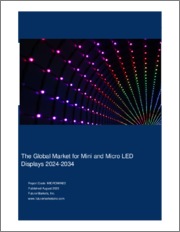
|
시장보고서
상품코드
1330292
세계의 Mini LED 및 Micro LED 디스플레이 시장(2024-2034년)The Global Market for Mini and Micro LED Displays 2024-2034 |
||||||
본 보고서는 세계 Mini LED 및 Micro LED 디스플레이 시장에 대해 조사 분석했으며, 시장 전망, 기술 과제, 시장 규모 예측, 기업 프로파일 등의 정보를 제공합니다.
목차
제1장 보고서의 목적
제2장 주요 요약
- Mini LED 시장
- Micro LED 시장
- 세계의 디스플레이 시장
- 디스플레이 기술 평가
- Mini LED/Micro LED의 이점
- Mini LED/Micro LED의 용도
- 시장과 기술 과제
- 산업 발전(2020년-2023년)
- 최근의 Mini LED/Micro LED 디스플레이 혁신
- 중국 시장 활동
- 세계의 Mini LED와 Micro LED 출하 예측(-2034년)
- Mini LED
- Micro LED
제3장 기술 분석
- Mini LED(mLED) vs. Micro LED(LED)
- 디스플레이 구성
- Mini LED 디스플레이
- LCD와 OLED와의 비교
- 장단점
- 백플레인 유형
- 비용
- High dynamic range Mini-LED 디스플레이
- Mini LED 디스플레이용 양자점 필름
- Mini LED 페로브스카이트 색소 증감 필름
- 시장 맵
- 시장 채택 로드맵
- Micro LED 디스플레이
- 개발
- 유형
- 생산
- LCD와 OLED 비교
- Micro LED 디스플레이 사양
- 이점
- 타일형 Micro LED 디스플레이
- 비용
- 제조
- 시장 맵
- 시장 채택 로드맵
제4장 세계의 Mini LED/Micro LED 시장
- 소비자용 전자 디스플레이 시장
- Mini LED 양자점 TV
- 제품
- 스마트워치, 웨어러블 기기
- 스마트폰
- Samsung
- LG
- TCL CSOT
- 랩톱, 모니터, 태블릿
- Mini LED
- Mini LED·Micro LED 랩톱, 모니터, 태블릿 제품, 프로토타입
제5장 플렉서블, 신축성, 접이식 Micro LED
- 세계의폴더블 디스플레이 시장
- 접이식 Micro LED 디스플레이
- 제품 개발자
제6장 바이오테크놀러지, 의료용 디스플레이
- 세계의 의료용 디스플레이 시장
- Micro LED
- 의료 용도 Micro LED
- 제품 개발자
제7장 자동차
- 세계의 자동차용 디스플레이 시장
- Mini LED
- 대시보드 디스플레이
- 헤드업 디스플레이(HUD)
- 디지털 계기 클러스터
- 앰비언트 조명
- 외장 조명
- Micro LED
- 헤드업 디스플레이(HUD)
- 헤드 램프
- 제품 개발자
제8장 가상현실(VR)·증강현실(AR)·혼합현실(MR)
- 세계의 가상현실(VR)·증강현실(AR)·혼합현실(MR) 시장
- Mini LED
- Micro LED
- AR/VR스마트 글래스, 헤드 마운트 디스플레이(HMD)(HMD)
- Micro LED 콘택트렌즈
- 제품과 프로토타입
제9장 투명 디스플레이
- 세계의 투명 디스플레이 시장
- Mini LED와 Micro LED 투명 디스플레이 용도
- 제품 개발자
제10장 공급망
- Mini LED
- Micro LED
제11장 기업 개요(92개사 개요)
제12장 참고 자료
LSH 23.09.18Mini- and Micro-LEDs are driving innovation in the global display market., offering superior performance, energy efficiency and visual quality compared to other display tech. Micro-LEDs are less than 1/10th the size of a traditional LED, allowing for a much higher pixel density, resulting in a sharper, more vibrant images. Mini-LEDs, while larger than Micro-LEDs, are still significantly smaller than conventional LEDs, and offer a middle ground between LED and Micro-LED tech, allowing for improved performance and efficiency at a lower price point than Micro-LEDs.
Micro-LED and Mini-LED displays consume significantly less power than traditional LED displays, reducing their environmental impact and also improving long-term cost-effectiveness. Lower power consumption results in less heat generation, which can extend the lifespan of the display.
Micro-LED and Mini-LED displays also offer superior visual quality. They can produce deeper blacks and brighter whites, resulting in a higher contrast ratio. They also offer a wider colour gamut. Due to their small size, they are also incorporated into flexible and stretchable displays, facilitating their application in markets including wearables and automotive displays. Apple and Samsung, already incorporate Mini- and Micro-LEDs into their products. Apple utilize Mini-LED technology in the iPad Pro, and Samsung has launched a Micro-LED TV range.
Report contents include:
- Analysis of the Mini- and Micro-LED markets, historical, current and future outlook.
- Benefits of Mini- and Micro-LEDs.
- Market and technology challenges.
- Industry news and developments 2020-2023.
- Recent mini- & micro-LED display innovations.
- Latest information on novel LED growth, transfer techniques, manufacturing and scale up.
- Global shipment forecasts to 2034.
- Global revenues to 2034.
- Analysis of Mini- and Micro-LED including advantages & disadvantages, costs, types of displays, manufacturing, market map, market adoption roadmaps and supply chain.
- Analysis of market for Mini- and Micro-LEDs including TVs, smartwatches & wearables, smartphones, laptops, monitors & tablets, advertising displays, flexible & foldable displays, automotive Head-up displays (HUD), headlamps, panels, Visible light communication (Li-Fi), Wearable biomedical devices, virtual reality (VR), augmented reality (AR) and mixed reality (MR) displays and transparent displays.
- In-depth profiles of 92 companies. Companies profiled include AU Optronics Corporation, Innolux Corporation, Japan Display Inc. (JDI), LG Display Co., Ltd., Mikro Mesa, NS Nanotech, PlayNitride, Inc., Q-Pixel, Raysolve Optoelectronics, Samsung, Seoul Semiconductor, TCL and Sitan Technology.
TABLE OF CONTENTS
1. REPORT AIMS AND OBJECTIVES
2. EXECUTIVE SUMMARY
- 2.1. The Mini-LED market
- 2.2. The Micro-LED market
- 2.3. The global display market
- 2.3.1. Display technologies assessment
- 2.4. Benefits of Mini- and Micro-LEDs
- 2.5. Mini- and Micro-LEDs applications
- 2.6. Market and technology challenges
- 2.7. Industry developments 2020-2023
- 2.8. Recent mini- & micro-LED display innovations
- 2.9. Market activity in China
- 2.10. Global shipment forecasts for Mini-LEDs and Micro-LEDs to 2034
- 2.10.1. Mini-LEDs
- 2.10.1.1. Units
- 2.10.1.2. Revenues
- 2.10.2. Micro-LEDs
- 2.10.2.1. Units
- 2.10.2.2. Revenues
- 2.10.1. Mini-LEDs
3. TECHNOLOGY ANALYSIS
- 3.1. Mini-LED (mLED) vs Micro-LED (µLED)
- 3.1.1. Display configurations
- 3.2. Mini-LED displays
- 3.2.1. Comparison to LCD and OLED
- 3.2.2. Advantages and disadvantages
- 3.2.3. Backplane types
- 3.2.4. Costs
- 3.2.5. High dynamic range Mini-LED displays
- 3.2.6. Quantum dot films for Mini-LED displays
- 3.2.7. Perovskite colour enhancement film in Mini-LEDs
- 3.2.8. Market map
- 3.2.9. Market adoption roadmap
- 3.3. Micro-LED displays
- 3.3.1. Development
- 3.3.1.1. Sony
- 3.3.2. Types
- 3.3.3. Production
- 3.3.3.1. Integration
- 3.3.3.2. Transfer technologies
- 3.3.4. Comparison to LCD and OLED
- 3.3.5. Micro-LED display specifications
- 3.3.6. Advantages
- 3.3.6.1. Transparency
- 3.3.6.2. Borderless
- 3.3.6.3. Flexibility
- 3.3.7. Tiled microLED displays
- 3.3.8. Costs
- 3.3.9. Manufacturing
- 3.3.9.1. Epitaxy and Chip Processing
- 3.3.9.1.1. Uniformity
- 3.3.9.2. Assembly Technologies
- 3.3.9.2.1. Monolithic fabrication of micro displays
- 3.3.9.2.2. Mass transfer
- 3.3.9.2.3. Mass Transfer Processes
- 3.3.9.2.3.1. Elastomer Stamp Transfer
- 3.3.9.2.3.2. Roll-to-Roll or Roll-to-Panel Imprinting
- 3.3.9.2.3.3. Laser-induced forward transfer (LIFT)
- 3.3.9.2.3.4. Electrostatic Transfer
- 3.3.9.2.3.5. Micro vacuum-based transfer
- 3.3.9.2.3.6. Adhesive Stamp
- 3.3.9.2.3.7. Fluidically Self-Assembled Transfer
- 3.3.9.3. Full colour conversion
- 3.3.9.3.1. Phosphor Colour Conversion LEDs
- 3.3.9.3.2. Quantum dots colour conversion
- 3.3.9.1. Epitaxy and Chip Processing
- 3.3.10. Market map
- 3.3.11. Market adoption roadmap
- 3.3.1. Development
4. THE GLOBAL MARKET FOR MINI- AND MICRO-LEDs
- 4.1. Consumer electronic display market
- 4.1.1. Mini-LED Quantum Dot TV
- 4.1.2. Products
- 4.2. Smartwatches and wearables
- 4.2.1. Apple's planned microLED smartwatch
- 4.2.2. Samsung
- 4.3. Smartphones
- 4.4. Samsung
- 4.4.1. Wall display
- 4.4.2. Neo QLED TV range
- 4.4.3. MicroLED CX TV line-up
- 4.5. LG
- 4.5.1. LG mini QNED range
- 4.5.2. MAGNIT Micro-LED TV
- 4.5.3. Stretchable 12" microLED touch displays
- 4.6. TCL CSOT
- 4.6.1. 8 Series and 6 Series
- 4.6.2. Micro-LED displays
- 4.7. Laptops, monitors and tablets
- 4.7.1. Mini-LED
- 4.7.2. Mini-LED and Micro-LED laptop, monitor and tablet products and prototypes
5. FLEXIBLE, STRETCHABLE AND FOLDABLE MICRO-LED
- 5.1. The global foldable display market
- 5.2. Foldable Micro-LED displays
- 5.3. Product developers
6. BIOTECH AND MEDICAL DISPLAYS
- 6.1. The global medical display market
- 6.2. Micro-LEDS
- 6.2.1. Micro-LEDs for medical applications
- 6.2.1.1. Implantable Devices
- 6.2.1.2. Lab-on-a-Chip
- 6.2.1.3. Endoscopy
- 6.2.1.4. Surgical Displays
- 6.2.1.5. Phototherapy
- 6.2.1.6. Biosensing
- 6.2.1. Micro-LEDs for medical applications
- 6.3. Product developers
7. AUTOMOTIVE
- 7.1. Global automotive displays market
- 7.2. Mini-LED
- 7.2.1. Dashboard Displays
- 7.2.2. Head-Up Displays (HUDs)
- 7.2.3. Digital Instrument Clusters
- 7.2.4. Ambient Lighting
- 7.2.5. Exterior Lighting
- 7.3. Micro-LEDs
- 7.3.1. Head-up display (HUD)
- 7.3.2. Headlamps
- 7.4. Product developers
8. VIRTUAL REALITY (VR), AUGMENTED REALITY (AR) AND MIXED REALITY (MR)
- 8.1. Global market for virtual reality (VR), augmented reality (AR), and mixed reality (MR)
- 8.2. Mini-LEDs
- 8.3. Micro-LEDs
- 8.3.1. AR/VR Smart glasses and head-mounted displays (HMDs)
- 8.3.2. Micro-LED contact lenses
- 8.3.3. Products and prototypes
9. TRANSPARENT DISPLAYS
- 9.1. Global transparent displays market
- 9.2. Mini-LED and Micro-LED transparent displays applications
- 9.3. Product developers
10. SUPPLY CHAINS
- 10.1. Mini-LEDs
- 10.2. Micro-LEDs


















